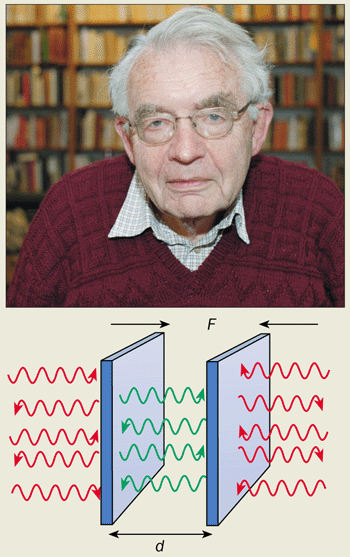

Zero Point Energy
Energy From The Vacuum of Space
The Casimir Effect
The Casimir Effect is the effect that shows that space is actually vacuum fluctuations which contains Zero Point Energy (ZPE) but extracting this energy is the difficulty.
Although the Casimir force seems completely counterintuitive, it is actually well understood. In the old days of classical mechanics the idea of a vacuum was simple. The vacuum was what remained if you emptied a container of all its particles and lowered the temperature down to absolute zero. The arrival of quantum mechanics, however, completely changed our notion of a vacuum. All fields – in particular electromagnetic fields – have fluctuations. In other words at any given moment their actual value varies around a constant, mean value. Even a perfect vacuum at absolute zero has fluctuating fields known as “vacuum fluctuations”, the mean energy of which corresponds to half the energy of a photon.
What happens if you take two mirrors and arrange them so that they are facing each other in empty space? Your first reaction might be “nothing at all”. In fact, both mirrors are mutually attracted to each other by the simple presence of the vacuum.
It turns out that, on balance, the attractive components have a slightly stronger impact than the repulsive ones. For two perfect, plane, parallel mirrors the Casimir force is therefore attractive and the mirrors are pulled together. The force, F, is proportional to the cross-sectional area, A, of the mirrors and increases 16-fold every time the distance, d, between the mirrors is halved: F ~ A/d4. Apart from these geometrical quantities the force depends only on fundamental values – Planck’s constant and the speed of light.
Casimir's demonstration to show existence of vacuum fluctuations:
https://physicsworld.com/a/the-casimir-effect-a-force-from-nothing/
Extracting energy from Zero Point field:
https://www.youtube.com/watch?v=oLEJTaY307E
Several methods are described but nothing practical has been achieved yet.
A former type of Mach effect thruster was the Mach-Lorentz thruster (MLT). It used a charging capacitor embedded in a magnetic field created by a magnetic coil. A Lorentz force, the cross product between the electric field and the magnetic field, appears and acts upon the ions inside the capacitor dielectric. In such electromagnetic experiments, the power can be applied at frequencies of several megahertz, unlike PZT stack actuators where frequency is limited to tens of kilohertz. The photograph shows the components of a Woodward effect test article used in a 2006 experiment.
However, a problem with some of these devices was discovered in 2007 by physicist Nembo Buldrini, who called it the Bulk Acceleration Conjecture:
What [Nembo Buldrini] pointed out was that given the way the transient terms of the Mach effect equation are written – in terms of the time-derivatives of the proper energy density – it is easy to lose sight of the requirement in the derivation that the object in which the mass fluctuations occur must be accelerating at the same time. In some of the experimental cases, no provision for such "bulk" acceleration was made.
As an example, the capacitors affixed to the tines of the tuning fork in the Cramer and the students' experiments made no provision for such an acceleration. Had the tuning fork been separately excited and an electric field applied to the capacitor(s) been properly phased, an effect might have been seen. But to simply apply a voltage to the capacitors and then look for a response in the tuning fork should not have been expected to produce a compelling result.
Other examples could be cited and discussed. Suffice it to say, though, that after Nembo focused attention in the issue of bulk accelerations in the production of Mach effects, the design and execution of experiments changed. The transition to that work, and recent results of experiments presently in progress, are addressed in the next chapter.
By "bulk" acceleration we are referring to the fact that the conditions of the derivation include that the object be both accelerated and experience internal energy changes. The acceleration of ions in the material of a capacitor, for example, does not meet this condition. The capacitor as a whole must be accelerated in bulk while it is being polarized.
— James F. Woodward
The components used to test the theory:
(I was not able to confirm any success or otherwise.)
Quantum Harmonic Oscillator: Quantum fluctuation
It is the graph of possible vacuum energy as discussed earlier.
Every accelerating and the smallest amount of energy packet present in the vacuum is called Quantum.
In this graph, there is also zero-point energy which is ground-level energy (lowest possible energy allowed in the quantum system). By this graph, we can clearly say that all real particle like electron exists above the zero-point energy level. No real particle exists below this level because every below zero-point energy is so low that no real particle can exist there.
Energy below this zero-point energy is a just disturbance in the vacuum energy that we call Virtual particles.
https://inventionsky.com/quantum-fluctuations/





